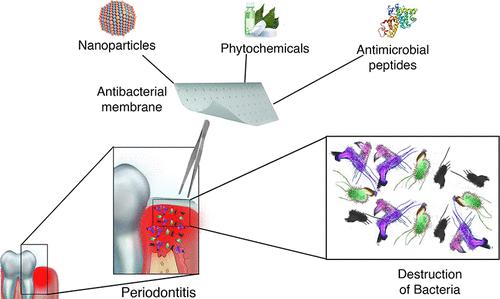当前位置:
X-MOL 学术
›
ACS Infect. Dis.
›
论文详情
Our official English website, www.x-mol.net, welcomes your feedback! (Note: you will need to create a separate account there.)
Addressing Antimicrobial Properties in Guided Tissue/Bone Regeneration Membrane: Enhancing Effectiveness in Periodontitis Treatment
ACS Infectious Diseases ( IF 5.3 ) Pub Date : 2024-02-01 , DOI: 10.1021/acsinfecdis.3c00568 Sara Takallu 1 , Esmaeil Mirzaei 1 , Abbas Zakeri Bazmandeh 1 , Hamid Reza Ghaderi Jafarbeigloo 2, 3 , Hooman Khorshidi 4
ACS Infectious Diseases ( IF 5.3 ) Pub Date : 2024-02-01 , DOI: 10.1021/acsinfecdis.3c00568 Sara Takallu 1 , Esmaeil Mirzaei 1 , Abbas Zakeri Bazmandeh 1 , Hamid Reza Ghaderi Jafarbeigloo 2, 3 , Hooman Khorshidi 4
Affiliation

|
Guided tissue regeneration (GTR) and guided bone regeneration (GBR) are the two surgical techniques generally used for periodontitis disease treatment. These techniques are based on a barrier membrane to direct the growth of new bone and gingival tissue at sites with insufficient volumes or dimensions of bone or gingiva for proper function, esthetics, or prosthetic restoration. Numerous studies have highlighted biocompatibility, space-creation, cell-blocking, bioactivity, and proper handling as essential characteristics of a membrane’s performance. Given that bacterial infection is the primary cause of periodontitis, we strongly believe that addressing the antimicrobial properties of these membranes is of utmost importance. Indeed, the absence of effective inhibition of periodontal pathogens has been recognized as a primary factor contributing to the failure of GTR/GBR membranes. Therefore, we suggest considering antimicrobial properties as one of the key factors in the design of GTR/GBR membranes. Antibiotics are potent medications frequently administered systemically to combat microbes and mitigate bacterial infections. Nevertheless, the excessive use of antibiotics has resulted in a surge in bacterial resistance. To overcome this challenge, alternative antibacterial substances have been developed. In this review, we explore the utilization of alternative substances with antimicrobial properties for topical application in membranes. The use of antibacterial nanoparticles, phytochemical compounds, and antimicrobial peptides in this context was investigated. By carefully selecting and integrating antimicrobial agents into GTR/GBR membranes, we can significantly enhance their effectiveness in combating periodontitis. These antibacterial substances not only act as barriers against pathogenic bacteria but also promote the process of periodontal healing.
中文翻译:

解决引导组织/骨再生膜的抗菌特性:提高牙周炎治疗的有效性
引导组织再生(GTR)和引导骨再生(GBR)是通常用于牙周炎疾病治疗的两种手术技术。这些技术基于屏障膜,在骨或牙龈体积或尺寸不足的部位引导新骨和牙龈组织的生长,以实现适当的功能、美观或修复体。许多研究强调生物相容性、空间创造、细胞阻断、生物活性和正确处理是膜性能的基本特征。鉴于细菌感染是牙周炎的主要原因,我们坚信解决这些膜的抗菌特性至关重要。事实上,缺乏对牙周病原体的有效抑制已被认为是导致 GTR/GBR 膜失效的主要因素。因此,我们建议将抗菌性能作为 GTR/GBR 膜设计的关键因素之一。抗生素是经常全身施用以对抗微生物和减轻细菌感染的强效药物。然而,抗生素的过度使用导致细菌耐药性激增。为了克服这一挑战,已经开发了替代抗菌物质。在这篇综述中,我们探索了具有抗菌特性的替代物质在膜中的局部应用的利用。研究了抗菌纳米粒子、植物化学化合物和抗菌肽在这方面的用途。通过仔细选择抗菌剂并将其整合到 GTR/GBR 膜中,我们可以显着增强其对抗牙周炎的功效。这些抗菌物质不仅可以阻挡病原菌,还可以促进牙周愈合过程。
更新日期:2024-02-01
中文翻译:

解决引导组织/骨再生膜的抗菌特性:提高牙周炎治疗的有效性
引导组织再生(GTR)和引导骨再生(GBR)是通常用于牙周炎疾病治疗的两种手术技术。这些技术基于屏障膜,在骨或牙龈体积或尺寸不足的部位引导新骨和牙龈组织的生长,以实现适当的功能、美观或修复体。许多研究强调生物相容性、空间创造、细胞阻断、生物活性和正确处理是膜性能的基本特征。鉴于细菌感染是牙周炎的主要原因,我们坚信解决这些膜的抗菌特性至关重要。事实上,缺乏对牙周病原体的有效抑制已被认为是导致 GTR/GBR 膜失效的主要因素。因此,我们建议将抗菌性能作为 GTR/GBR 膜设计的关键因素之一。抗生素是经常全身施用以对抗微生物和减轻细菌感染的强效药物。然而,抗生素的过度使用导致细菌耐药性激增。为了克服这一挑战,已经开发了替代抗菌物质。在这篇综述中,我们探索了具有抗菌特性的替代物质在膜中的局部应用的利用。研究了抗菌纳米粒子、植物化学化合物和抗菌肽在这方面的用途。通过仔细选择抗菌剂并将其整合到 GTR/GBR 膜中,我们可以显着增强其对抗牙周炎的功效。这些抗菌物质不仅可以阻挡病原菌,还可以促进牙周愈合过程。



























 京公网安备 11010802027423号
京公网安备 11010802027423号